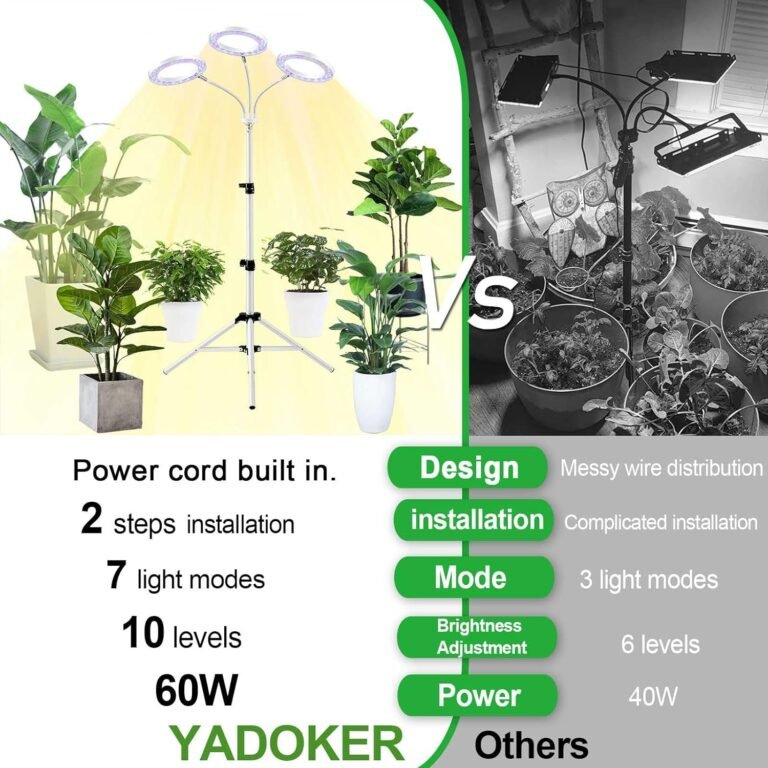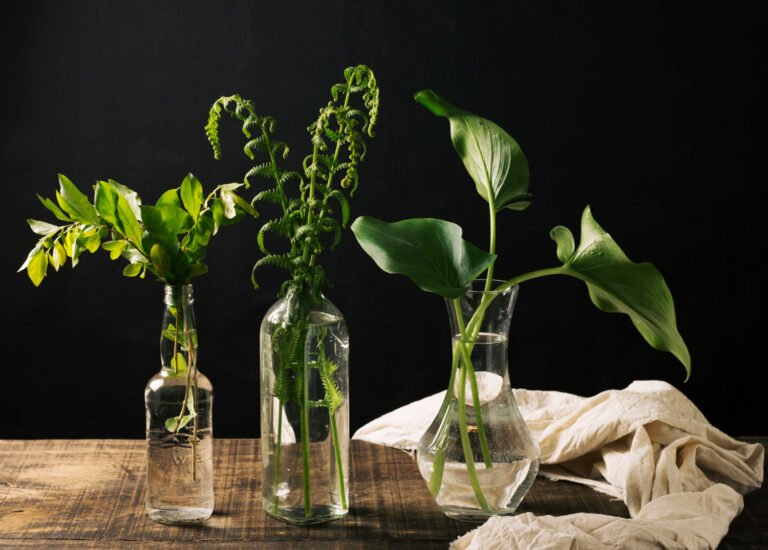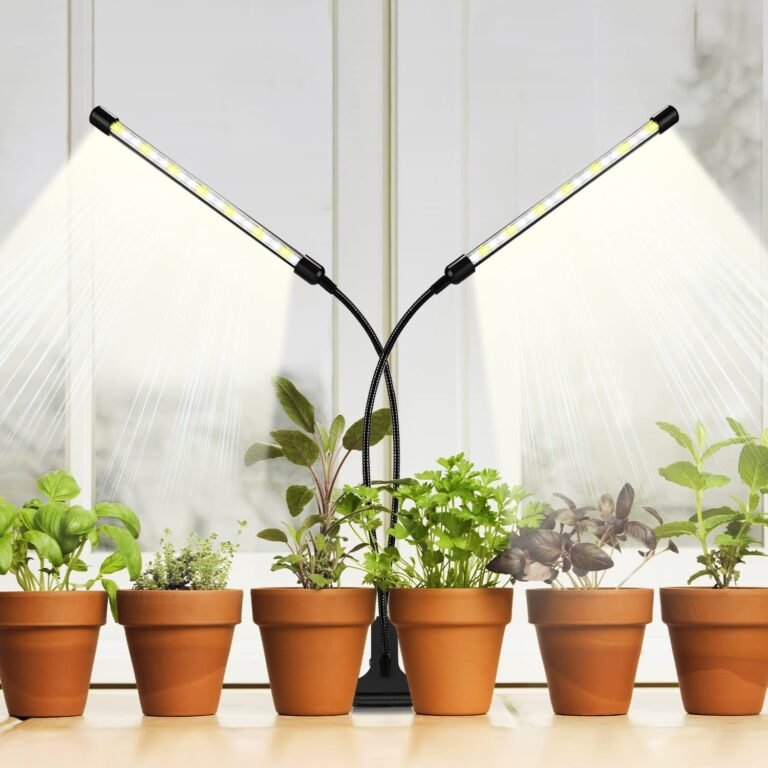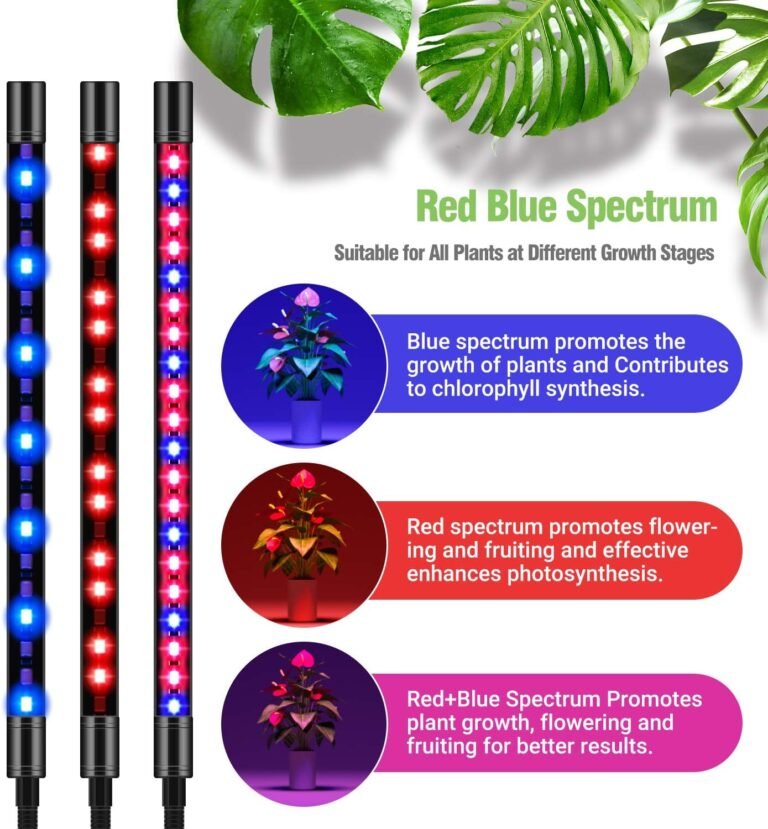Indoor plants have a unique charm that can transform any living space into a lush, green oasis. However, for these plants to thrive, they require adequate light. While natural sunlight is the ideal source of energy for plant growth, it’s not always available, especially for those of us who live in regions with long, dark winters or have limited access to outdoor spaces. This is where grow lights for plants come to the rescue, offering a solution that allows you to cultivate a thriving indoor garden.
In this comprehensive guide, we’ll delve into the world of grow lights, exploring the different types, their benefits, and how to choose the right one for your indoor plants. Whether you’re a seasoned indoor gardener or just starting, this overview will equip you with the knowledge you need to nurture your plants with the perfect amount of light.
The Importance of Light for Indoor Plants
Before we dive into the specifics of how plants grow without lights, let’s understand why light is crucial for indoor plants. Light is an essential factor in photosynthesis, the process through which plants convert light energy into chemical energy to fuel their growth. Without an adequate light source, plants can become leggy, weak, and unable to produce flowers or fruits.
Natural Light vs. Grow Lights
Natural Light
Natural light, typically from the sun, provides the full spectrum of light that plants need for photosynthesis. However, relying solely on natural sunlight indoors can be challenging, as it depends on factors like geographic location, weather, and the orientation of your windows.

Grow Lights
This is where grow lights come into play. These artificial light sources are designed to mimic the spectrum of natural light, ensuring that your indoor plants receive the right type and intensity of light for optimal growth. With the right grow light fixtures, you can create a consistent and controlled environment for your plants to thrive, regardless of the season or location.

Understanding the Light Spectrum
When it comes to grow lights, it’s essential to understand the light spectrum and its different components, as they directly influence plant growth. The two key components of the spectrum that are of particular interest to indoor gardeners are blue light and red light.
Blue Light
Blue light, which falls in the range of 400-500 nanometers, is crucial for vegetative growth. It encourages compact and bushy plant growth, making it ideal for seedlings, herbs, and leafy greens.
Red Light
Red light, on the other hand, falls in the range of 600-700 nanometers and is essential for flowering and fruiting. Plants that receive an adequate amount of red light tend to produce more flowers and fruits.
Blue and Red Light Combination
Many modern grow lights are designed to provide a balanced combination of blue and red light, as this closely mimics the natural light spectrum that plants need. This “full spectrum” approach ensures healthy plant growth throughout all stages of development.
Types of Grow Lights
Now that we’ve covered the basics of why light is essential for indoor plants and the key components of the light spectrum, let’s explore the different types of grow lights available:
1. Fluorescent Lights
Fluorescent bulbs have long been a popular choice among indoor gardeners. They are energy-efficient and emit a spectrum of light that works well for a wide range of plants, making them suitable for a variety of indoor gardening setups.
2. LED Grow Lights
LED (Light Emitting Diode) lights have gained immense popularity in recent years due to their energy efficiency and longevity. They come in various spectrums, including full spectrum, making them versatile for different plant types.
3. Incandescent Grow Lights
Incandescent bulbs are less commonly used for indoor gardening due to their lower energy efficiency and heat output. However, they can still be effective for specific plant types.
4. High-Intensity Discharge (HID) Lights
HID lights, such as High-Pressure Sodium (HPS) and Metal Halide (MH) lights, are incredibly powerful and suitable for larger plants or commercial indoor gardens. They emit intense light but also produce significant heat, requiring both proper lighting and ventilation.
In the upcoming sections, we’ll delve deeper into each type of grow light, exploring their pros and cons, and helping you make an informed choice for your indoor garden. Stay tuned for a closer look at fluorescent lights and LED grow lights in our next installment!
If you’ve found this overview on the different types of grow lights insightful and want to delve deeper into fine-tuning your indoor gardening skills, don’t forget to subscribe to our blog. Join our community of avid indoor gardeners to stay updated on the latest technology, tips, and tricks in the indoor gardening world. Together, let’s bring the power of nature indoors!
Fluorescent Lights: Illuminating Your Indoor Garden
In our previous installment, we introduced the world of grow lights and discussed the significance of light for indoor plant growth. Now, let’s shed some light on fluorescent lights, one of the popular choices among indoor gardeners.
The Bright Side of Fluorescent Lights
Fluorescent bulbs have been a staple in indoor gardening for many years, and for good reason. Here are some of the advantages they offer:
1. Energy Efficiency: Fluorescent lights are known for their energy efficiency, making them an eco-friendly choice. They produce more light per watt compared to incandescent light bulbs, helping you save on electricity bills.
2. Cooler Temperatures: Unlike some other types of grow lights, fluorescent bulbs emit light with minimal heat. This is beneficial for preventing your plants from overheating and can even reduce the need for additional cooling systems.
3. Versatility: Fluorescent lights come in various spectrums, including cool white, warm white, and full spectrum. This versatility allows you to choose the right spectrum for your specific plant needs.
4. Suitable for Seedlings and Herbs: Fluorescent lights are excellent for nurturing seedlings and growing herbs and leafy greens. Their gentle light encourages healthy, compact growth in young plants.
Types of Fluorescent Lights
There are two primary types of fluorescent lights commonly used in indoor gardening:
1. T5 Fluorescent Lights: T5 lights are slender, energy-efficient tubes that provide high-intensity light. They are popular for starting seeds and growing small to medium-sized plants.
2. T8 and T12 Fluorescent Lights: These are wider tubes that are less energy-efficient than T5 lights but are still effective for growing plants. They are often used in larger indoor gardening setups.
The Drawbacks of Fluorescent Lights
While fluorescent lights offer several benefits, it’s essential to be aware of their limitations:
1. Limited Coverage Area: Fluorescent lights have a limited coverage area, so they may not be suitable for larger or taller plants.
2. Less Intense Light: Compared to some other types of grow lights, fluorescent lights provide lower light intensity. This can affect the growth of certain light-hungry plants.
3. Lifespan: Fluorescent bulbs have a finite lifespan and will need to be replaced periodically.
4. Spectrum Limitations: While they are versatile, the spectrum of fluorescent lights may not be as tailored as some other types of grow lights for specific plant stages.
LED Grow Lights: Lighting the Way to Indoor Gardening Success
Welcome back to our exploration of grow lights for indoor plants! In Part 2, we discussed fluorescent lights and their role in nurturing indoor gardens. Now, let’s step into the world of LED grow light and lights, which have revolutionized indoor gardening with their efficiency and versatility.
The Brilliance of LED Grow Lights
LED (Light Emitting Diode) grow lights have become the go-to choice for many indoor gardeners, and for good reasons. Here’s why LED grow lights shine in the world of indoor gardening:
1. Energy Efficiency: LED grow lights are incredibly energy-efficient, often using significantly less electricity than other types of grow lights. This not only reduces your energy bills but also minimizes your environmental footprint.
2. Longevity: LED bulbs have a remarkably long lifespan, often lasting tens of thousands of hours. This means fewer bulb replacements, saving you time and money in the long run.
3. Customizable Spectrum: Many LED grow lights allow you to customize the light spectrum to match your plants’ specific needs. This adaptability makes them suitable for all stages of plant growth, from seedlings to flowering.
4. Minimal Heat Emission: LED lights produce bright light but very little heat, reducing the risk of overheating your plants. You won’t need additional cooling systems in your indoor garden.
5. Compact Design: LED grow lights come in various sizes and shapes, including panels and bulbs. Their compact design makes them suitable for a wide range of indoor gardening setups, from small shelves to dedicated grow rooms.
Types of LED Grow Lights
There are several types of LED grow lights on the market, each with its own advantages:
1. Full Spectrum LED Grow Lights: These lights provide a balanced spectrum that closely mimics natural sunlight, making them ideal for a wide range of plants throughout their growth cycle.
2. Red and Blue LED Grow Lights: These lights are designed to cater to specific stages of plant growth. Red light promotes flowering and fruiting of a few plants, while blue light encourages vegetative growth.
3. COB LED Grow Lights: COB (Chip-on-Board) LEDs are powerful and energy-efficient. They offer high-intensity light in a compact package, making them suitable for larger plants.
The LED Advantage
While LED grow lights offer numerous benefits, it’s essential to consider your specific gardening needs and budget. Here are a few factors to keep in mind:
1. Upfront Cost: LED grow lights can have a higher upfront cost than some other options. However, their energy efficiency and long lifespan can offset this initial investment.
2. Light Intensity: LED lights can be intense, so it’s crucial to position them at the right distance from your plants to avoid light stress.
3. Brand and Quality: Quality matters when it comes to LED grow lights. Investing in a reputable brand ensures you get the best performance and durability.
Indoor Grow Lights: Tailoring Light for Plant Variety
Welcome back to our exploration of grow lights for indoor gardening! In Part 3, we unveiled the brilliance of LED grow lights and how they’ve transformed the indoor gardening landscape. Now, let’s dive deeper into indoor grow lights and their diverse applications.
The Magic of Indoor Grow Lights
Indoor grow lights are a category of artificial lighting specifically designed to cater to the unique needs of different plant varieties. Whether you’re growing tropical houseplants or succulents, there’s an indoor grow light to suit your needs. Here’s how they work their magic:
1. Plant Variety Customization: Indoor grow lights are available in various spectrums, allowing you to tailor the full light output to the specific needs of your plants. This customization ensures your plants receive the ideal light spectrum for their growth stage.
2. Intensity Control: Many indoor grow lights come with adjustable intensity settings, enabling you to provide just the right amount of light for your plants without overexposing them.
3. Plant-Specific Lights: Some indoor grow lights are designed with specific plant varieties in mind. For instance, there are lights tailored for succulents, orchids, and even carnivorous plants, ensuring they receive the optimal light conditions for thriving.
Supplementation with Indoor Grow Lights
While natural light is beneficial, it may not always be sufficient for certain plant varieties. Indoor grow lights can serve as supplementary or supplemental light sources, ensuring your plants get the energy they need to grow vigorously. Here are some scenarios where indoor grow lights shine:
1. Low-Light Spaces: If you have a room with limited natural light, indoor grow lights can make a significant difference in the health and growth of your plants.
2. Overcast Days: Even on cloudy days, indoor grow lights provide consistent, quality light to keep your plants thriving.
3. Winter Months: In regions with long winters or reduced daylight hours, indoor grow lights are essential for maintaining plant health.
4. Extended Growing Seasons: If you want to extend the growing season for plants that typically wouldn’t have enough light to survive outdoors during certain months, indoor grow lights can provide the necessary light energy.
Finding the Right Indoor Grow Light
When selecting an indoor grow light, consider the following factors:
1. Plant Variety: Choose a light spectrum that suits the specific needs of your plants. For example, tropical plants may benefit from a full-spectrum light, while succulents may thrive under a more focused spectrum.
2. Light Intensity: Ensure the light intensity is adjustable or appropriate for your plants’ growth stage. Some seedlings require gentler light, while flowering plants may need higher intensity.
3. Size and Placement: Select an indoor grow light that fits your indoor gardening space. Consider how and where you will hang or position the light to ensure uniform coverage.
4. Budget: LED grow lights are often a cost-effective choice due to their energy efficiency and longevity. Consider your budget when making your green light selection.
With the right indoor grow light, you can transform any indoor space into a thriving garden. Whether you’re growing herbs, tropical plants, or succulents, there’s a lighting solution that will meet your plant’s unique needs.
FAQs on Indoor Grow Lights
What type of light is best for growing plants indoors?
The best type of light for growing plants indoors is full-spectrum light. This light closely mimics natural sunlight and provides plants require a balanced spectrum of blue and red light, which is essential for the entire plant growth cycle.
Can any LED light be used as a grow light?
Not all LED lights are suitable for plant growth. To be effective, LED grow lights need to provide the right spectrum of light, including blue and red wavelengths, and offer sufficient intensity for plant growth.
Do grow lights actually help plants?
Yes, grow lights are designed to provide the necessary light energy for photosynthesis, promoting healthy plant growth, flowering, and fruiting, especially in indoor environments with limited natural light.
What kind of grow light do plants need?
Plants need a grow light that offers a balanced spectrum of blue and red light, similar to natural sunlight. Full-spectrum LED grow lights are often the best choice for indoor gardening.
What is the best grow light on the market right now?
The “best” grow light depends on your specific needs, plant varieties, and budget. Reputable brands like Philips, Mars Hydro, and Spider Farmer offer quality LED grow lights. Research and choose one that suits your requirements.
What are some of the best grow lights?
Some highly-rated grow lights include the Spider Farmer SF-2000, Mars Hydro TS 1000, and the HLG Quantum Board series. However, the best grow light for you will depend on your specific gardening goals and conditions.
What light is best for plant growth?
For plant growth, a full-spectrum light that includes blue and red wavelengths is ideal. This spectrum violet light promotes both vegetative growth and flowering/fruiting stages, ensuring overall plant health.
What is the best lighting for a plant?
The best lighting for a plant is a full-spectrum grow light that provides the necessary wavelengths for photosynthesis. It should be tailored to the plant’s growth stage and specific needs.
What is the best way to light plants indoors?
The best way to light plants indoors is to use full-spectrum LED grow lights positioned at the appropriate distance from your plants. Ensure that the light intensity and duration match your plant’s requirements.







